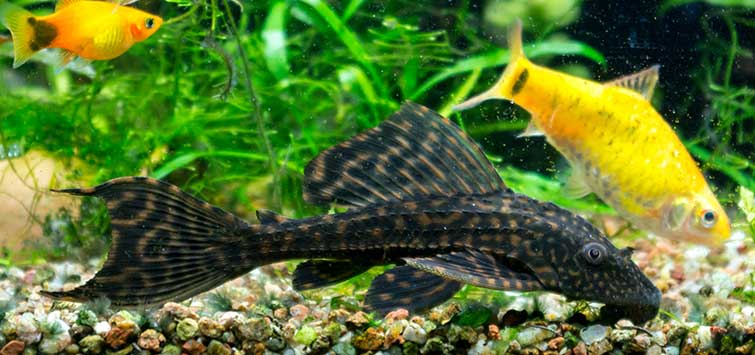The Planted Tank: Impulse Buying for the Planted Aquarium
Author: Rhonda Wilson
Though buying fish on the spur of the moment is never recommended, most aquarists will, at one time or another, make a spontaneous decision to buy new fish for their aquarium. Whether wandering into a new store to see what they have, or just stopping in at an old favorite shop, sometimes the urge to purchase a fish on impulse is too strong to resist.
I recently went to a few local aquarium stores to see what they had to offer. I wanted to see what fish were most commonly offered in the larger chain stores, since these are the sorts of fish most people will find when shopping for their own aquariums. What surprised me most is how similar the variety of small fish available was to the selection offered by the small independent shops I frequented in my youth.
There were many different small- and medium-sized tetras, quite a few barbs and catfish, and a few danios. Most of these fish should, in general, be suitable for a planted aquarium depending on its size, water conditions, and other tank inhabitants. An old favorite of mine, the kuhli loach, was often strangely absent from the shops. Other fish that weren’t readily available in the past, such as Australian rainbows, have become common in shops. The rainbows are colorful, large, schooling fish that work well in large planted aquariums.
Shops also have many fish that are generally unsuitable for the planted aquarium. Many aquarists have horror stories about little fish that grew into huge monsters, often eating sculpted gardens and many tankmates on the way. These were usually impulse purchases that they later regretted. If you’re going to make an impulse purchase, at least use what you already know to make an educated one.
MAKING AN INFORMED CHOICE
A lot of your knowledge about various fish can give you an advantage when considering fish you don’t know about. Similar fish in the same family often have somewhat similar requirements. While that is not always true, it is a start. Most of the small fish commonly available are suitable in a planted aquarium. There are of course many variables, and specific information about the animals you’re considering is much more desirable.
Your first source of information should be the store employees. In a perfect world, the employees of the pet store should know at least basic information about aquariums and the specific fish they sell. Sadly this is not always the case. It’s always handy to have employees you’ve built up a trusting relationship with, ones who have offered good information in the past.
But if it’s someone new, or you’re at a new shop, don’t be afraid to test them a bit. Find out if they know at least as much as you do. Ask them about fish, plants, or an aquarium topic that you know a little about before you ask them about that beautiful new fish you’ve never heard of before.
Some enlightened aquarium shops keep copies of aquarium books on hand to use as references for employees and customers. These are in addition to the books and magazines they may sell. So if you’re in doubt of what an employee is saying or you have concerns about the fish, ask an employee if they have any books that reference the fish you are considering. Keeping a guide to fish in your vehicle for quick reference could be an option if you find yourself wanting to purchase fish on the spur of the moment regularly.
THINGS TO CONSIDER BEFORE PURCHASE
Foolish purchases can not only lead to loss of life for the new fish, but also for the ones you currently have. Be sure you actually have room for your new fish before you purchase them. If you don’t have room for them, or they won’t get along with the fish you have, perhaps you should consider buying another aquarium on that trip and get the fish after you’ve cycled it. Some stores will even hold fish for you while you set up the new tank.
As with all fish, keep in mind that the animals need to work well not only with your plants but also with any other inhabitants of the aquarium. Some fish are perfectly suitable for the home aquarium, but that doesn’t mean they’ll be compatible with all of your other fish. A beautiful male betta and zebra daniosare both commonly found fish that are easy to keep and suitable for the planted aquarium. However, it may be difficult to keep them together if the school of danios decide the betta’s fins are fun to nip at.
By thinking ahead, some of these conflicts can be avoided. For instance, try getting fish that live in different areas of the aquarium. A school of small Corydoras will usually be on the bottom of the tank and won’t even come into contact that often with a school of cardinal tetras in the same aquarium. (Care should be taken so the corys would get suitable food at their level, though.) Also consider the eventual size of the fish. Avoid combining tankmates that are significantly different in size so that one fish doesn’t become food for another.
In addition to compatibility with other tank inhabitants, remember that new fish will also have to be able to live comfortably in the conditions you provide. Fish that are most comfortable in a hardwater environment are not going to be happy if you’re intending on putting them in a planted tank that is filled with RO water and uses additional CO2.
GENERAL TYPES OF FISH TO CONSIDER
When choosing fish randomly, some choices are going to be safer than others. For those of you that are regular readers, you probably know I have a soft spot in my heart for livebearers. All of the colorful common livebearers should be suitable for most planted aquariums.
Most of the small and colorful schooling fish offered at pet stores are generally suitable for planted aquariums. Tetras, danios, rasboras, white clouds, pencilfish, cories, and rainbows are usually suitable, colorful fish. On the other hand, some barbs are problematic due to their herbivorous tendencies—they cannot all be trusted with live plants.
Small killies are also good fish for the planted aquarium, though they can be short lived. Although some killies are annuals and have to have their eggs dried and stored, quite a few of these fish are good breeders in a planted aquarium. Eggs can develop and hatch, and fry will grow to adulthood. Many other small fish are also very good fish for the planted aquarium and will often breed freely.
Some small cichlids can do quite well in a community planted aquarium, but not all that many. Some small cichlids can move half the gravel in a tank in one day, shredding the plants and undoing all your aquascaping efforts. Don’t purchase a cichlid if you aren’t familiar with the needs and temperament of that particular species of fish.
Not only do you want to make sure you have fish that won’t eat your plants, bulldoze the substrate, or kill each other, you also may want to consider how the colors will look with your setup, decorations, and other fish. Too many different colors and patterns can be distracting. Using some restraint and only a few different species of fish will produce more attractive results. Once again, sometimes the best answer to wanting more fish is to set up additional aquariums.
PREDICTING SIZE
Very often you can accurately guess the adult size of a species on the basis of its close relatives. But not always!
The least killifish Heterandria formosa is common in the hobby. This is the smallest fish in the U.S. and one of the smallest vertebrates in the world. Adult females are under an inch, and the males are much smaller. None of the other species in this genus are routinely found in the aquarium trade, but it would be a mistake to speculate on their size based on H. formosa. All of its congeners are much larger, 3 to 6 inches.
THINGS TO AVOID
The size of a fish when you buy it has no predictive power—a 6-foot fish was once an inch long! Always determine how large a fish will grow before buying it. Never believe the ignorant story about fish that will stay as small as their tanks—if an employee tells you that, you should question everything else they tell you. Unless you’ve already researched the fish and have a plan in mind, it’s best to stay away from possibly large, destructive fish. Remember that the most common fish-purchase regret people have is in ending up with large, difficult-to-keep fish. The larger the fish will become, the harder it will be to keep.
Goldfish are found everywhere, but they are a poor idea for planted aquariums. And though some large cichlids are suitable for planted aquariums, very few are, and these fish should be avoided unless you’ve done proper research and found which fish would be suitable with which plants. Obviously, herbivorous fish of any size are a poor choice for the planted tank.
MORE GENERAL TIPS
Always be sure to check the health of the fish in the entire shop, as well as the condition of their aquariums. In my years of traipsing through fish stores, I can’t really recall seeing many particularly visually dirty tanks in retail establishments. However, it’s very common to see sick fish. In one of the shops I went to recently, many of the tanks had fish that were very obviously infected with ich. I believe this shop has all of their aquariums on one system. They often have some nice fish there, but they also often have these ich outbreaks.
These diseases can be highly contagious and wipe out your entire aquarium. Check all fish for signs of illness or disease on their bodies. Dead fish are, of course, also a bad sign. Things happen, and fish sometimes die, but finding several dead fish in multiple tanks is a really bad sign. Even if all the fish look healthy, be smart and quarantine all new fish before adding them to your existing population.
Keeping a hard foam box or cooler in your vehicle to transport your fish home is a good idea. It will keep them from getting too warm or cold depending on the time of year and your location. It also keeps the plastic fish bags from rolling around on the floor of your vehicle, which is distracting and very hard on the fish.
And be sure to look your new fish up and find out more information about them after you bring them home. Yes, it would have been better to know before you bought them, but it’s still a good idea to find out what you’ve really gotten yourself into.
See the full article on TFH Digital http://www.tfhdigital.com/tfh/201101#pg33

.png?h=595&iar=0&w=2781&hash=5FD5E69473BCC22199FBFA2FB71B6033)








